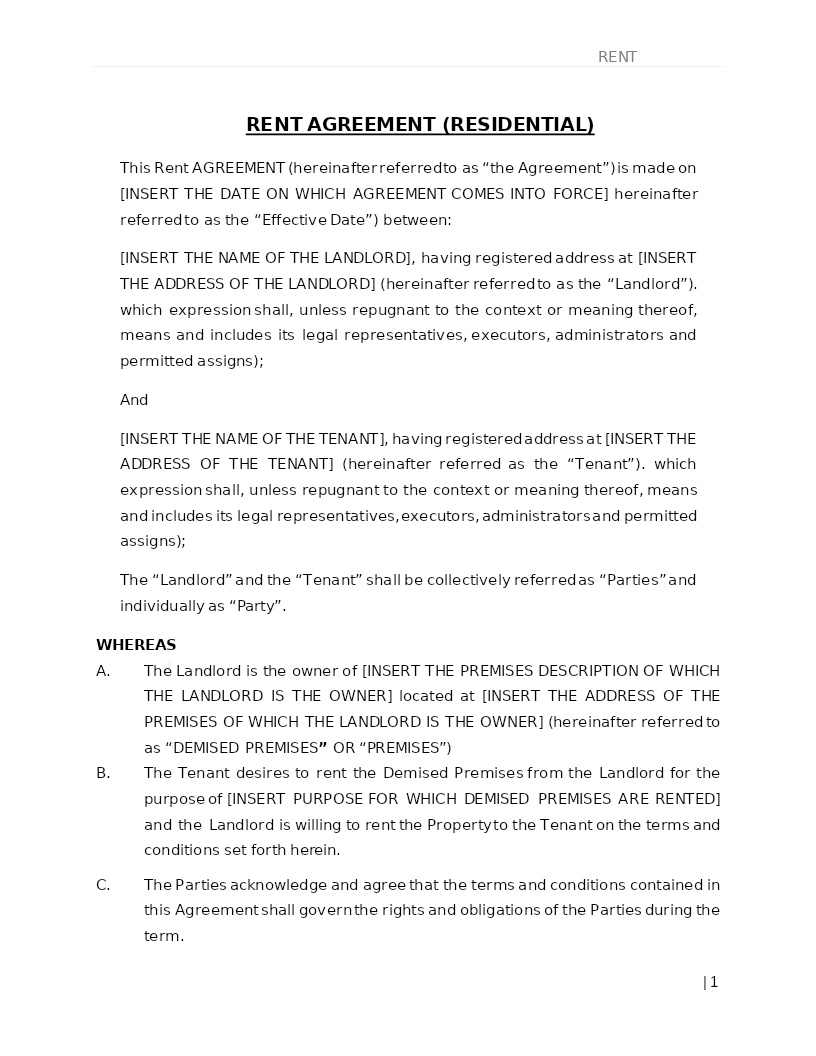
RENT AGREEMENT (RESIDENTIAL)
How does it work?
1. Choose this template
Start by clicking on "Fill out the template"
2. Complete the document
Answer a few questions and your document is created automatically.
3. Save - Print
Your document is ready! You will receive it in Word and PDF formats. You will be able to modify it.
What is Rent Agreement?
Rent Agreement (also known as a Lease Agreement) is a legally binding contract between a property owner (Lessor / Landlord) and an occupant (Lessee / Tenant) that outlines the terms and conditions under which the property is rented for residential or commercial purposes.
It defines the rights, responsibilities, and obligations of both parties and establishes the duration, rent amount, payment terms, maintenance obligations, and conditions for renewal or termination. Rent Agreements help prevent disputes by providing written evidence of the tenancy arrangement, ensuring transparency, and protecting the interests of both the landlord and the tenant.
This template is:
• Lawyer-drafted and legally neutral, suitable for use across multiple jurisdictions.
• Applicable to both residential and commercial rental arrangements.
• Covers rent amount, security deposit, maintenance responsibilities, termination, and dispute resolution.
• Customisable for varying tenancy periods, property types, and local legal requirements.
Key Features of a Rent Agreement
1. Parties to the Agreement
Clearly identifies the Lessor (owner) and Lessee (tenant), including their legal names, contact details, and addresses.
2. Description of Property
Specifies the rented property’s details like address, type (residential), and components such as rooms, facilities, or parking areas.
3. Rent and Payment Terms
States the agreed monthly/periodic rent, mode of payment, due date, and any provisions for rent escalation during the term.
4. Security Deposit
Mentions the amount of security deposit, refund terms, and permissible deductions (if any) for damages or unpaid dues.
5. Duration and Renewal
Defines the lease period (fixed-term or periodic), commencement date, and procedure for renewal or extension.
6. Maintenance and Repairs
Allocates responsibilities for regular maintenance, repairs, and utility payments, ensuring clarity and accountability.
7. Use and Restrictions
Outlines the permitted use of the property, prohibition of unlawful activities, and compliance with local building or occupancy laws.
8. Termination and Notice
Specifies the conditions and notice period for early termination by either party and the procedure for handover of possession.
9. Subletting and Assignment
States whether the tenant may sublet, assign, or transfer the tenancy rights, subject to landlord’s written consent.
10. Governing Law and Dispute Resolution
Provides that the agreement shall be interpreted in accordance with applicable tenancy or property laws of the relevant jurisdiction, and disputes may be resolved through mutual discussion, mediation, or arbitration.
Why You Need a Rent Agreement?
• Establishes legal clarity on rent, tenure, and rights of both parties.
• Protects landlord’s ownership and tenant’s possession rights.
• Serves as documentary proof for address, taxation, and registration.
• Prevents future disputes over payment, maintenance, or eviction.
• Ensures compliance with local rent control and registration laws.
FAQs on Rent Agreements
Q1: Is a Rent Agreement legally binding?
Yes. Once signed by both parties and properly stamped or registered (as required by local law), it becomes a legally enforceable document.
Q2: Is registration of a Rent Agreement mandatory?
For leases exceeding the statutory period (commonly 11 months or more, depending on jurisdiction), registration is mandatory for legal validity and enforceability.
Q3: Can a Rent Agreement be executed electronically?
Yes. Many jurisdictions recognize e-signatures and electronic agreements, provided applicable electronic transaction laws are complied with.
Q4: Can the Rent be increased during the term?
Only if the agreement includes a rent escalation clause or both parties mutually agree in writing.
Q5: What happens if either party breaches the agreement?
The aggrieved party may seek remedies such as termination, recovery of damages, or eviction, in accordance with applicable tenancy and contract laws.
Related Templates You May Need
• Building Maintenance Agreement
• Property Management Agreement